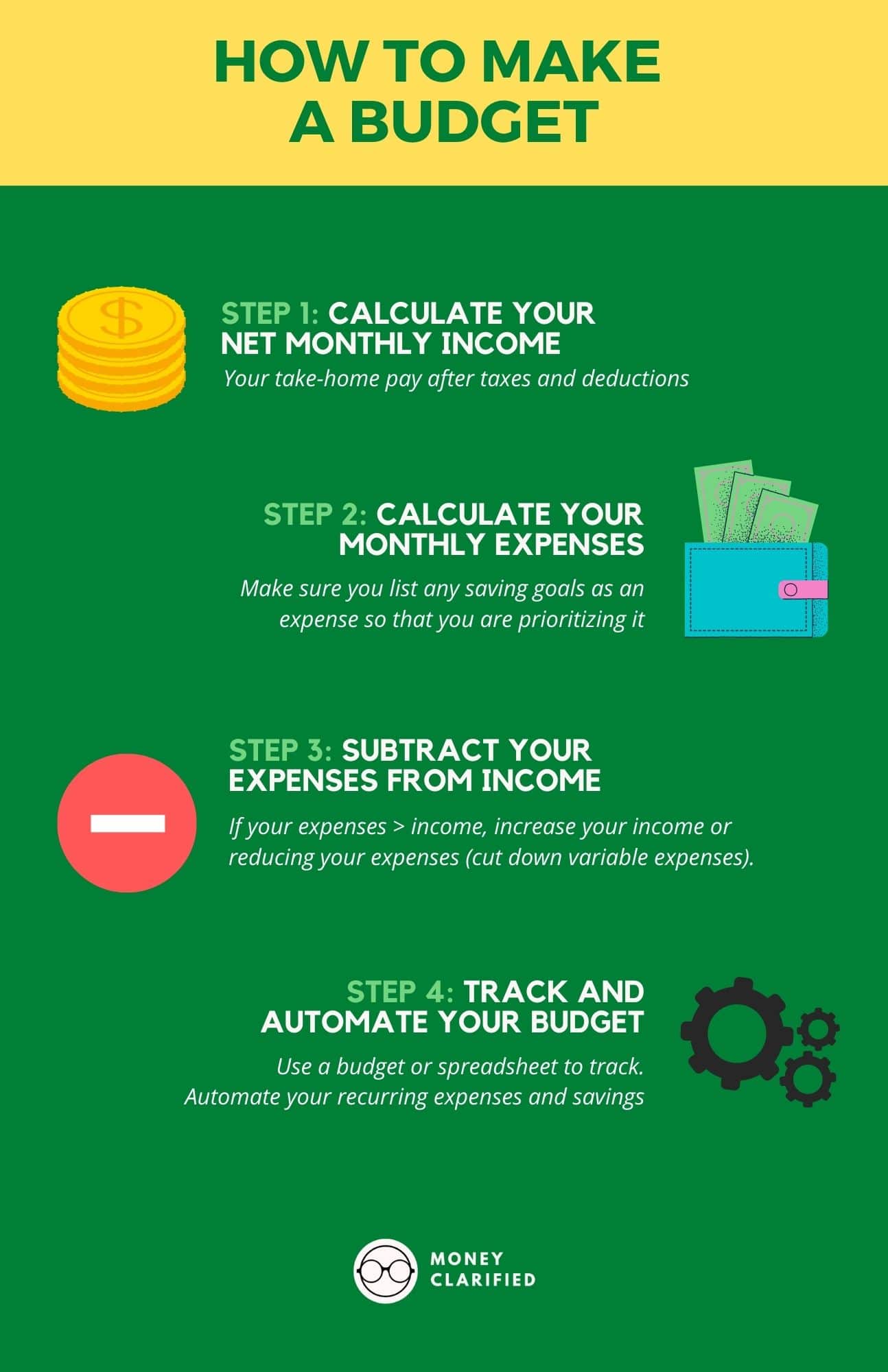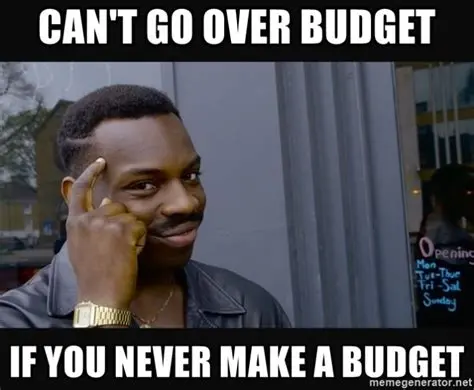This post may contain affiliate links. We may receive compensation when you click on links to those products at no additional cost to you. Read our full disclosure here.
Budgeting is an essential part of personal finance management. It is a simple process that involves creating a plan to manage your income and expenses to ensure that you have enough money to cover all your needs while still saving for the future.
In this ultimate guide to budgeting for beginners, we will discuss everything you need to know about budgeting, including the benefits, the different types of budgets, and the steps to create and maintain a budget.
What is Budgeting, Anyway?
Budgeting is basically like mapping out how you’re gonna spend your hard-earned cash. It’s the game plan for your money, where you track your income, expenses, and savings goals to ensure you’re not burning through your money faster than they’re coming in.
It involves determining your income, listing your expenses, prioritizing your expenses, and setting realistic goals. A budget helps you manage your money, so you can pay your bills on time, cover unexpected expenses, and save for the future.
You can think of your financial life as a map, with different destinations representing your various financial goals. Just like when planning a trip, you need a budget to ensure that you reach each destination successfully.

Why is Budgeting Important?
Budgeting is essential because it helps you take control of your finances. When you have a budget, you know exactly how much money you have coming in and going out.
This knowledge helps you make informed decisions about your spending, so you can prioritize your needs and wants. Additionally, budgeting helps you save for the future, whether it’s for emergencies, retirement, or other financial goals.
Different Types of Budgets
There are different types of budgets, and each one has its advantages and disadvantages. We’ll talk about four popular ones in this ultimate guide to budgeting for beginners:
Zero-Based Budgeting
Zero-based budgeting is a method that requires you to assign a job to every dollar you earn. This means that you start from scratch each month and allocate all of your income towards specific categories, such as rent, groceries, entertainment, and even savings.
The goal of zero-based budgeting is to have a zero balance at the end of each month, which means that all of your income has been allocated toward a specific expense. This method requires you to be very disciplined with your spending, as there is no wiggle room for extra expenses.
Envelope Budgeting
Envelope budgeting is a method that involves using physical envelopes to allocate money for different expenses. You put cash in each envelope, and when the money in the envelope is gone, you can’t spend any more money in that category for the month.
This method can be very effective for people who have trouble with overspending, as it forces you to stick to a predetermined budget. However, it can be difficult to use (and time-consuming) if you prefer to make purchases online or with a credit card.
50/30/20 Budgeting
50/30/20 budgeting is a method that involves dividing your income into three categories: 50% for needs, 30% for wants, and 20% for savings and debt repayment. This method allows you to prioritize your spending, so you can cover your necessities while still having some money for fun and savings.
The 50/30/20 method is easy to understand and implement, and it can be a good option for people who are new to budgeting.
Pay Yourself First Budgeting
The Pay Yourself First budgeting system is probably one of my favorite types of budget as it prioritizes savings by setting aside a portion of your income before you pay any bills or expenses. The idea is to pay yourself first by contributing to your savings or investment accounts before spending money on anything else.
This method can be effective because it helps you build savings habits and ensures that you are putting money toward your financial goals. It can also be a good way to budget if you have trouble saving money consistently.
To use this method, you should determine a specific amount or percentage of your income that you want to save each month. Then, set up an automatic transfer to your savings or investment account so that the money is transferred as soon as you receive your paycheck. This way, you won’t be tempted to spend the money on other things.
Here is a comparison table for the 4 budgeting systems mentioned above:
Budgeting Systems
| Budgeting System | Method | Pros | Cons |
| Zero-Based Budgeting | Start from scratch each month | Every dollar is accounted for, encourages mindfulness and planning | Time-consuming to set up and maintain |
| Envelope Budgeting | Use physical envelopes to allocate money for expenses | Helps with overspending and impulse purchases | Can be inconvenient to carry cash and manage envelopes |
| 50/30/20 Budgeting | Divide income into three categories: needs, wants, savings/debt | Allows for flexibility and prioritizes spending | May not work for everyone's income and expenses |
| Pay Yourself First Budgeting | Prioritize savings by setting aside a portion of income first | Builds savings habits and ensures money is put towards goals | May be difficult to consistently save if expenses are high |
Steps to Create a Budget
I’ve written a more detailed guide about creating a budget here. See below for a simplified and concise version of the ultimate guide to budgeting for beginners:

- Determine Your Income: The first step is to determine your total monthly income, including all sources of income. Make sure to use your take-home pay after taxes and deductions for this number!
- Track Your Expenses: Keep track of your expenses for a month. This will give you an idea of where your money is going. It will be helpful to divide your expenses into different categories, such as rent/mortgage, utilities, groceries, transportation, entertainment, and others for tracking purposes.
- Compare Your Monthly Income and Expenses: Determine whether your income is more than expenses. If your expenses are too high, determine which expenses are necessities and which are luxuries, prioritize your spending accordingly, and make the appropriate adjustments.
- Automate Your Budget: Once you have identified your expenses and potential discretionary income, automate your budget as much as possible to minimize major fluctuations.
- Track Your Progress: Review your budget by using budgeting apps like Personal Capital or budgeting spreadsheets regularly to make sure you are sticking to it. Adjust your budget as needed and keep working towards your financial goals.
Budgeting Apps Vs. Budgeting Spreadsheets
Managing and tracking your budget on a consistent basis is key to the foundation of budgeting and money management. I’ve gotten a lot of questions about which type of budgeting tool is best so here are my thoughts – There are two main ways to manage and track your budget that I’ll include in this ultimate guide to budgeting for beginners: the modern way of budgeting apps; and the more traditional way of using spreadsheets.
Budgeting Apps
Pros
- User-friendly interface: Budgeting apps are designed to be easy to use, even for those who are not familiar with spreadsheets or financial management.
- Automated tracking: Many budgeting apps automatically track and categorize transactions, which saves time and effort.
- Real-time updates: Budgeting apps typically provide real-time updates on spending and budgeting progress, which can help individuals stay on track and make informed decisions.
- Integration with other financial tools: Some budgeting apps can integrate with other financial tools, such as bank accounts and investment platforms, to provide a comprehensive view of an individual’s finances.
Cons
- Cost: Some budgeting apps require a monthly or annual subscription fee, which can add up over time.
- Limited customization: While budgeting apps provide pre-set categories and budgeting templates, they may not allow for much customization beyond that.
- Security concerns: As budgeting apps require access to an individual’s financial data, there are potential security concerns if the app is not properly secured.
Examples of budgeting apps
- Mint: Mint is a popular budgeting app that automatically tracks transactions and provides real-time updates on spending.
- YNAB (You Need A Budget): YNAB is a budgeting app that uses a unique budgeting method called “zero-based budgeting” to help individuals prioritize their spending.
- Personal Capital: Personal Capital is a budgeting app that provides a comprehensive view of an individual’s finances, including bank accounts, investments, and retirement accounts.
Spreadsheets:
Pros
- Customizable: Spreadsheets allow for complete customization of budgeting templates and categories.
- No additional cost: Spreadsheets are typically free and readily available on most devices.
- Offline availability: Spreadsheets can be used without an internet connection, which can be helpful for those without consistent access to the internet.
Cons
- Time-consuming: Spreadsheets require manual input of transactions and budgeting progress, which can be time-consuming and may not be ideal for those with busy schedules.
- Limited automation: Spreadsheets do not have automated tracking and categorization capabilities like budgeting apps.
- Steep learning curve: Spreadsheets can be difficult to use for those who are not familiar with how to manually create a budget and/or using a spreadsheet software.
Examples of spreadsheet software
- Microsoft Excel: Microsoft Excel is a spreadsheet software that allows for the complete customization of budgeting templates and categories. Here is one of my favorite personal budget templates from the legend Vertex42
- Google Sheets: Google Sheets is a free spreadsheet software that can be accessed from any device with an internet connection.
- Apple Numbers: Apple Numbers is a spreadsheet software designed for Mac and iOS devices, which allows for easy integration with other Apple software.
Both budgeting apps and spreadsheets have their own advantages and disadvantages. It is up to each individual to determine which tool is best suited for their budgeting styles.
Tips to Maintain Your Budget
Maintaining a budget can be challenging, but here are some tips for the ultimate guide to budgeting for beginners to help you stay on track:
- Review your budget regularly to ensure that you are staying on track.
- Set aside money for unexpected expenses, aka emergency/rainy day funds. For example, car repairs, home repairs, medical bills, etc. This can help you avoid going over budget or dipping into your savings when unexpected expenses arise.
- Avoid unnecessary expenses, such as eating out or impulse purchases. This can include things like eating out or making impulse purchases. By avoiding these types of expenses, you can free up more money in your budget to put toward your financial goals.
- Use cash or debit cards instead of credit cards to avoid overspending. When you use cash or a debit card, you can only spend the amount of money that you have available, and there also is a “pain of paying” in cash that can help limit spending. This can help you stay within your budget and avoid racking up credit card debt.
- Don’t be too hard on yourself if you slip up. Just make adjustments and keep moving forward.
Benefits of Budgeting
There are many benefits of budgeting, including:
- It helps you take control of your finances
- It reduces stress and anxiety about money
- It helps you prioritize your spending
- It allows you to save for the future
- It helps you achieve your financial goals
Common Budgeting Mistakes
Here are some common mistakes people make when creating and maintaining a budget:
- Not tracking their expenses
- Underestimating their expenses
- Not accounting for unexpected expenses
- Failing to adjust their budget as needed
- Being too rigid with their budget
- Not having a budget

Conclusion
Budgeting is an essential part of your foundation to achieve financial freedom and build wealth. It helps you take control of your finances, prioritize your spending, and save for the future. By following the steps outlined and knowing the various tips to manage your budget in this ultimate guide to budgeting for beginners, you can create a budget that works for you and achieve your financial goals.
FAQs
Q: What is the best budgeting method?
A: The best budgeting method is the one that works best for you. It’s important to experiment with different methods to find one that suits your needs and lifestyle. The ones outlined in this ultimate guide to budgeting for beginners are to help you compare.
Q: How often should I review my budget?
A: You should review your budget regularly, at least once a month. This will help you stay on track and make adjustments as needed.
Q: Can I save money while paying off debt?
A: Yes, you can save money while paying off debt. It’s important to set realistic goals and prioritize your debt repayment while still setting aside some money for savings.
Q: How can I stick to my budget?
A: To stick to your budget, you should track your expenses, set realistic goals, avoid unnecessary expenses, and make adjustments as needed. It’s also important to be kind to yourself, not be too hard on yourself if you slip up, and refer back to this ultimate guide to budgeting for beginners if you need to.
This post may contain affiliate links. We may receive compensation when you click on links to those products at no additional cost to you. Read our full disclosure here.






